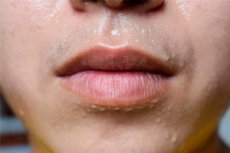New publications
Innovative sweat analysis device enables non-invasive health monitoring
Last reviewed: 02.07.2025

All iLive content is medically reviewed or fact checked to ensure as much factual accuracy as possible.
We have strict sourcing guidelines and only link to reputable media sites, academic research institutions and, whenever possible, medically peer reviewed studies. Note that the numbers in parentheses ([1], [2], etc.) are clickable links to these studies.
If you feel that any of our content is inaccurate, out-of-date, or otherwise questionable, please select it and press Ctrl + Enter.

Researchers from the Korea Advanced Institute of Science and Technology (KIST), together with Professor John A. Rogers of Northwestern University, have announced the creation of a sweat monitoring device that does not require physical activity but stimulates sweating by delivering drugs through the skin. Unlike previous methods that required physical exercise to induce sweating, this device delivers sweat gland-stimulating drugs directly through the skin.
Sweat contains biomarkers that can track a variety of health conditions, from diabetes to genetic disorders. Sweat collection, as opposed to blood sampling, is preferred by users because it is painless. However, previously, getting enough nutrients or hormones from sweat required intense physical activity, which created problems for people with limited mobility.
Development of the device The research team developed a flexible device that can deliver drugs to sweat glands by applying a current to a hydrogel containing the drugs. The device, which is small and soft, can be easily attached to the skin. Sweat induced by the drug is collected in micro-fluidic channels within the device and analyzed for biomarkers using biosensors. This allows for the analysis of biomarkers in sweat, reducing the need for time-consuming hospital visits for testing and reducing the risk of biomarker contamination during testing, improving accuracy.
The device developed by the research team was attached to infants with cystic fibrosis and the concentration of chloride, a biomarker in sweat, was confirmed. The results were comparable to those obtained by traditional methods of analyzing sweat collected in hospitals, with an accuracy of more than 98%. The stability of the device on the skin was also confirmed by measuring skin temperature and pH values. Since cystic fibrosis mainly manifests itself in infancy, continuous monitoring of the disease progression and physical condition is necessary. With this device, monitoring can be easily carried out at home, reducing psychological and physical stress for children and their caregivers.
The new device helps expand non-invasive sweat-based disease monitoring technologies in healthy adults. In addition, transdermal drug delivery technology can be used not only to induce sweat, but also to increase the rate of drug delivery to localized areas such as skin diseases or wounds, accelerating their healing.
Dr. Kim Ju-hee from KIST's Bionic Research Center said, "Through two years of joint research with Northwestern University, we have not only solved the problems of existing sweat induction methods, but also achieved success in clinical trials, bringing us one step closer to commercialization."
Professor John A Rogers added: "We plan to undertake large-scale clinical trials and commercialisation, including in adults, in the future."
This research was conducted under the KIST Major Projects and the Outstanding Young Researcher Program (RS-2023-00211342) supported by the Ministry of Science and ICT (Minister Lee Jong-ho). The research results were recently published online in the latest issue of the international journal "Biosensors & Bioelectronics" (IF 12.6).
The results of the study were published in the journal ScienceDirect.
